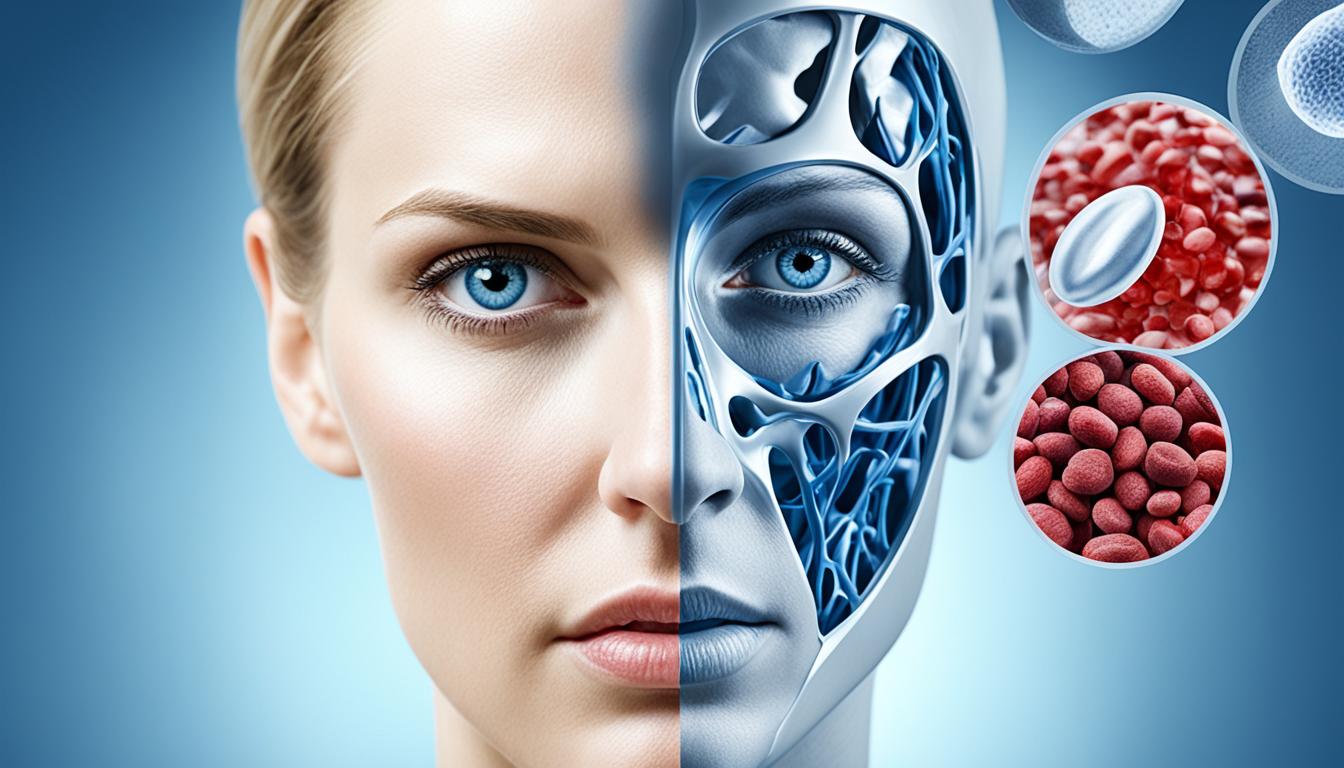Iron deficiency anemia is a health problem that affects many worldwide. It’s especially common among women and children. This condition appears when the body doesn’t have enough iron. Because of this, not enough red blood cells are made. With correct treatment, people can recover their health.
People with this kind of anemia may feel very tired and look pale. They might find it hard to breathe. All these issues happen because the body needs iron to make hemoglobin. Hemoglobin is a protein that helps carry oxygen. Without it, oxygen can’t get to the body’s cells enough.
Different things can cause iron deficiency anemia. Not eating enough iron-rich foods like red meat, greens, and fortified cereals is one cause. Another reason can be losing blood often, like in heavy periods or from the gut.
Key Takeaways:
- Iron deficiency anemia happens when the body doesn’t have enough iron to make the right amount of red blood cells.
- Feeling exhausted, weak, out of breath, and having pale skin are common signs.
- A diet poor in iron and frequent blood loss can bring on this type of anemia.
- Changing what you eat, taking iron pills, and finding why iron is low are ways to treat it.
- Catching and dealing with iron deficiency anemia early can make a big difference for those affected.
Causes of Iron Deficiency Anemia
Iron deficiency anemia happens when the body lacks enough iron. Several things can mess with how much iron the body gets or uses. It’s important to know these causes to fight anemia well.
Diet low in iron-rich foods
Not eating enough iron-rich food is a big reason for anemia. Foods like red meat, poultry, fish, and dark green veggies help the body make red blood cells. Adding these foods to your meals is a smart way to keep anemia away.
Poor iron absorption
The body might not absorb iron well because of some diseases or surgeries. This means even if you eat plenty of iron, your body might not use much of it. It’s key to handle these health issues to absorb iron better.
Chronic blood loss
Losing blood over a long time can drop your iron levels. This includes heavy periods or bleeding in the stomach. These issues can lead to anemia. Finding the cause of your blood loss and treating it helps avoid anemia.
Solving iron deficiency anemia means dealing with its causes. Focus on eating foods rich in iron, making sure your body absorbs iron well, and stopping long-term blood loss. This helps keep your iron levels up and prevents anemia.
Symptoms and Diagnosis of Iron Deficiency Anemia
Iron deficiency anemia shows itself in various ways. Signs like fatigue, weakness, and shortness of breath are common. You may also notice pale skin.
If these symptoms sound familiar, you might also feel dizzy, have headaches, or cold hands and feet. If any of these symptoms worry you, talk to a healthcare pro.
Doctors often first do a complete blood count to check for this. They look at your hemoglobin and red blood cells. If these are low, it could mean you have anemia.
More tests might be needed to be sure and find out why you’re anemic. They can include checking your ferritin levels and doing iron studies.
Iron Deficiency Anemia Diagnosis Tests
| Test | Explanation |
|---|---|
| Complete Blood Count (CBC) | Measures hemoglobin and red blood cell levels |
| Ferritin Levels | Measures the protein that stores iron in the body |
| Iron Studies | Measures various markers of iron levels in the blood |
These tests help figure out if you have anemia and how bad it is. They also help find the reasons behind it. This info is key for the right treatment plan.
Treatment of Iron Deficiency Anemia
Treating iron deficiency anemia starts with getting more iron into your system. Eating foods like lean meats, beans, and spinach helps a lot. So does adding iron-fortified cereals to your meals. This boosts the iron in your body and helps make more red blood cells.
Your doctor might also give you iron supplements. You should take them just like your doctor says. It’s smart to take these supplements with vitamin C. Vitamin C helps your body absorb iron better. You can get vitamin C from citrus fruits or supplements.
Dealing with the cause of the anemia is also important. If heavy periods make you lose more iron, your doctor might look at managing this. They could suggest hormonal treatments. Or they might focus on other steps to control the bleeding. For people with gut problems that cause ongoing blood loss, treating the gut issue is key. This can help stop the anemia from coming back.

